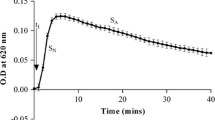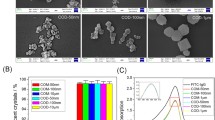Abstract
Costus arabicus L. (C. arabicus) is a plant used in Brazilian folk medicine to treat urolithiasis; however, its mechanism of action is unclear. The interaction between calcium oxalate (CaOx) crystals and the renal epithelium is important in calculogenesis, and compounds that modulate this process represent candidate therapeutic agents for stone prevention. Therefore, we assessed the inhibitory activity of C. arabicus on CaOx crystallization and the interaction of CaOx crystals with the renal epithelium. A seeded CaOx monohydrate (COM) crystallization system was used to study the effect of C. arabicus on crystal growth. Madin Darby canine kidney (MDCK) cells were used to study [14C] COM crystal adhesion in the presence and absence of an aqueous extract of C. arabicus. Cytotoxicity was assessed using a tetrazolium (MTS) cell proliferation assay. Aqueous extracts of C. arabicus decreased crystal growth in a concentration-dependent fashion. Precoating crystals with C. arabicus extract prevented their adhesion to MDCK cells, while pretreating cells did not show any effect. The extract was non-cytotoxic in concentrations of at least 1 mg/ml, which is likely above concentrations achievable in the urine following oral ingestion and excretion. No inhibitory activity was found in hexane, methyl chloride, n-butanol and ethyl acetate fractions of an ethanol extract of the herb. An aqueous extract of C. arabicus may disrupt calculogenesis by interacting with CaOx crystal surfaces. Activity was present in the aqueous extract; therefore, this agent may be bioavailable when administered orally. Fractionation results suggest that the active agent might be a polar polysaccharide. Further identification and characterization along these lines may be warranted.





Similar content being viewed by others
References
Tiselius HG (2003) Epidemiology and medical management of stone disease. BJU Int 91:758–767
Park S, Pearle MS (2007) Pathophysiology and management of calcium stones. Urol Clin North Am 34:323–334
Lee JH, Yehl M, Ahn KS et al (2009) 1,2,3,4,6-Penta-O-galloyl-beta-d-glucose attenuates renal cell migration, hyaluronan expression, and crystal adhesion. Eur J Pharmacol 606:32–37
Gurocak S, Kupeli B (2006) Consumption of historical and current phytotherapeutic agents for urolithiasis: a critical review. J Urol 176:450–455
Hinman F Jr (1979) Directional growth of renal calculi. J Urol 121:700–705
Evan AP, Coe FL, Gillen D et al (2008) Renal intratubular crystals and hyaluronan staining occur in stone formers with bypass surgery but not with idiopathic calcium oxalate stones. Anat Rec (Hoboken) 291:325–334
Evan AP, Lingeman JE, Coe FL et al (2005) Crystal-associated nephropathy in patients with brushite nephrolithiasis. Kidney Int 67:576–591
Randall A (1937) The origin and growth of renal calculi. Ann Surg 105:1009–1027
Evan AP, Lingeman JE, Coe FL et al (2003) Randall’s plaque of patients with nephrolithiasis begins in basement membranes of thin loops of Henle. J Clin Investig 111:607–616
Evan AP, Coe FL, Lingeman JE et al (2006) Renal crystal deposits and histopathology in patients with cystine stones. Kidney Int 69:2227–2235
Araujo Viel T, Diogo Domingos C, da Silva Monteiro AP et al (1999) Evaluation of the antiurolithiatic activity of the extract of Costus spiralis Roscoe in rats. J Ethnopharmacol 66:193–198
Braga FG, Bouzada ML, Fabri RL (2007) et al Antileishmanial and antifungal activity of plants used in traditional medicine in Brazil. J Ethnopharmacol 111:396–402
Britto RM, Santos AL, Cruz JS et al (2011) Aqueous fraction from Costus spiralis (Jacq.) Roscoe leaf reduces contractility by impairing the calcium inward current in the mammalian myocardium. J Ethnopharmacol 138:382–389
Habsah M, Amran M, Mackeen MM et al (2000) Screening of Zingiberaceae extracts for antimicrobial and antioxidant activities. J Ethnopharmacol 72:403–410
Silvia BPBR, Parente JP (2000) Flavonol glycosides from Costus spicatus. Phytochemistry 53:87
Silvia BPPJ (2003) Bioactive polysaccharides from Costus spicatus. Carbohydr Polym 51:239
Whittle BA (1964) The use of changes in capillary permeability in mice to distinguish between narcotic and nonnarcotic alalgesics. Br J Pharmacol Chemother 22:246–253
Pak CY, Ohata M, Holt K (1975) Effect of diphosphonate on crystallization of calcium oxalate in vitro. Kidney Int 7:154–160
Wesson JA, Worcester EM, Wiessner JH et al (1998) Control of calcium oxalate crystal structure and cell adherence by urinary macromolecules. Kidney Int 53:952–957
Cunha FAB, Matias EFF, Brito SV et al (2011) In vitro antibacterial, phototoxic, and synergistic activity of ethanol extracts from costus cf. arabicus L. J Med Food 14:964–968
Acknowledgments
This work was supported by the Mayo Clinic O’Brien Urology Research Center P50 DK083007 and U54 DK100227, the Mayo Foundation, a National Research Foundation of Korea (NRF) Grant funded by the Korean government (No. 20120004977) and a Korea Science and Engineering Foundation (KOSEF) Grant (MEST 2012-0005755).
Conflict of interest
None declared.
Author information
Authors and Affiliations
Corresponding authors
Rights and permissions
About this article
Cite this article
de Cógáin, M.R., Linnes, M.P., Lee, H.J. et al. Aqueous extract of Costus arabicus inhibits calcium oxalate crystal growth and adhesion to renal epithelial cells. Urolithiasis 43, 119–124 (2015). https://doi.org/10.1007/s00240-015-0749-5
Received:
Accepted:
Published:
Issue Date:
DOI: https://doi.org/10.1007/s00240-015-0749-5




